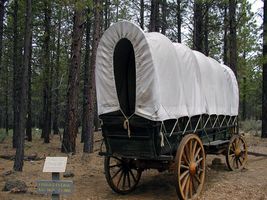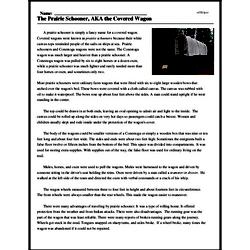The Prairie Schooner, AKA the Covered Wagon
A prairie schooner is simply a fancy name for a covered wagon. Covered wagons were known as prairie schooners because their white canvas tops reminded people of the sails on ships at sea. Prairie schooners and Conestoga wagons were not the same. The Conestoga wagon was much larger and heavier than a prairie schooner. A Conestoga wagon was pulled by six to eight horses or a dozen oxen, while a prairie schooner was much lighter and rarely needed more than four horses or oxen, and sometimes only two.
Most prairie schooners were ordinary farm wagons that were fitted with six to eight large wooden bows that arched over the wagon's bed. These bows were covered with a cloth called canvas. The canvas was rubbed with oil to make it waterproof. The bows rose up about four feet above the sides. A man could stand upright if he were standing in the center.
The top could be drawn in at both ends, leaving an oval opening to admit air and light to the inside. The canvas could be rolled up along the sides on very hot days so passengers could catch a breeze. Women and children usually slept and rode inside under the protection of the wagon's cover.




